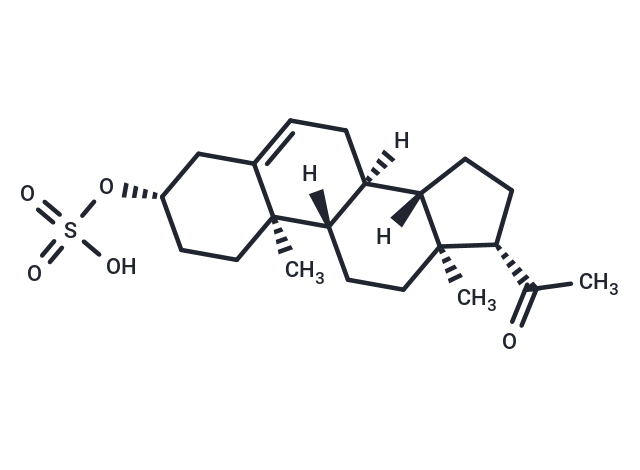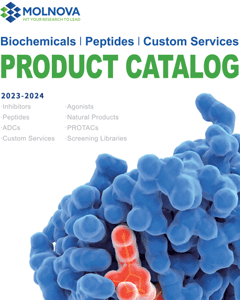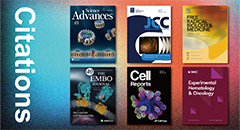
Pregnenolone monosulfate
CAS No. 1247-64-9
Pregnenolone monosulfate( —— )
Catalog No. M33076 CAS No. 1247-64-9
Pregnenolone monosulfate (3β-Hydroxy-5-pregnen-20-one monosulfate) is a potent nootropic steroid that positively regulates NMDA recordings and is utilized in the study of neuroticism and depression.
Purity : >98% (HPLC)
 COA
COA
 Datasheet
Datasheet
 HNMR
HNMR
 HPLC
HPLC
 MSDS
MSDS
 Handing Instructions
Handing Instructions
| Size | Price / USD | Stock | Quantity |
| 5MG | 44 | Get Quote |


|
| 10MG | 61 | Get Quote |


|
| 25MG | 116 | Get Quote |


|
| 500MG | Get Quote | Get Quote |


|
| 1G | Get Quote | Get Quote |


|
Biological Information
-
Product NamePregnenolone monosulfate
-
NoteResearch use only, not for human use.
-
Brief DescriptionPregnenolone monosulfate (3β-Hydroxy-5-pregnen-20-one monosulfate) is a potent nootropic steroid that positively regulates NMDA recordings and is utilized in the study of neuroticism and depression.
-
DescriptionPregnenolone monosulfate (3β-Hydroxy-5-pregnen-20-one monosulfate) is a powerful neurosteroid, the main precursor of various steroid hormones including steroid ketones. Pregnenolone monosulfate acts as a signaling-specific inhibitor of cannabinoid CB1 receptor, inhibits the effects of tetrahydrocannabinol (THC) that are mediated by the CB1 receptors. Pregnenolone monosulfate can protect the brain from cannabis intoxication. Pregnenolone monosulfate is also a TRPM3 channel activator, and also can weakly activate TRPM1 channels.
-
In VitroCB1 receptor stimulation increases brain Pregnenolone levels, which in turn exerts a negative feedback on the activity of the CB1 receptor antagonizing most of the known behavioral and somatic effects of THC. Pregnenolone likely acts as a signaling-specific negative allosteric modulator binding to a site distinct from that occupied by orthosteric ligands. Pregnenolone does not modify agonist binding but only agonist efficacy.The effect of THC is significantly attenuated when slices are pre-treated with Pregnenolone 100 nM (15.1±1.8 % of inhibition). These effects are likely due to a pre-synaptic action of Pregnenolone. Thus, Pregnenolone blocks the increase in paired-pulse ratio (PPR) induced by THC but does not modify either the amplitude or the decay time of miniature EPSC (mEPSC).
-
In VivoPregnenolone administration (2-6 mg/kg) blocks THC-induced food-intake in Wistar rats and in C57BL/6N mice, and blunts the memory impairment induced by THC in mice, but it does not modify these behaviors per se. Injections of Pregnenolone (2 and 4mg/kg) before each self-administration session reduce the intake of WIN 55,212-2 and reduce the break-point in a progressive ratio schedule.
-
Synonyms——
-
PathwayMembrane Transporter/Ion Channel
-
TargetNMDAR
-
RecptorNMDAR
-
Research Area——
-
Indication——
Chemical Information
-
CAS Number1247-64-9
-
Formula Weight396.54
-
Molecular FormulaC21H32O5S
-
Purity>98% (HPLC)
-
SolubilityIn Vitro:?DMSO : 62.5 mg/mL (157.61 mM; Ultrasonic )
-
SMILESC[C@@]12[C@@]3([C@]([C@]4([C@](C)(CC3)[C@@H](C(C)=O)CC4)[H])(CC=C1C[C@@H](OS(=O)(=O)O)CC2)[H])[H]
-
Chemical Name——
Shipping & Storage Information
-
Storage(-20℃)
-
ShippingWith Ice Pack
-
Stability≥ 2 years
Reference
1. Vallée M, et al. Pregnenolone can protect the brain from cannabis intoxication. Science. 2014 Jan 3;343(6166):94-8.?
molnova catalog



related products
-
Lanicemine dihydroch...
Lanicemine dihydrochloride (AZD-6765 dihydrochloride) is a low-capture NMDA channel blocker with antidepressant activity and can be used to study neurological diseases.
-
MDL 29951
MDL-29951 is a novel glycine antagonist of NMDA receptor activation (Ki=0.14 mM, [3H]glycine binding) in vitro and in vivo.
-
CIQ
CIQ is a subunit-selective potentiator of NMDA receptors containing the NR2C or NR2D subunit. EC50 value: 2.7 μM for NR2C and 2.8 μM for NR2D.



 Cart
Cart
 sales@molnova.com
sales@molnova.com


